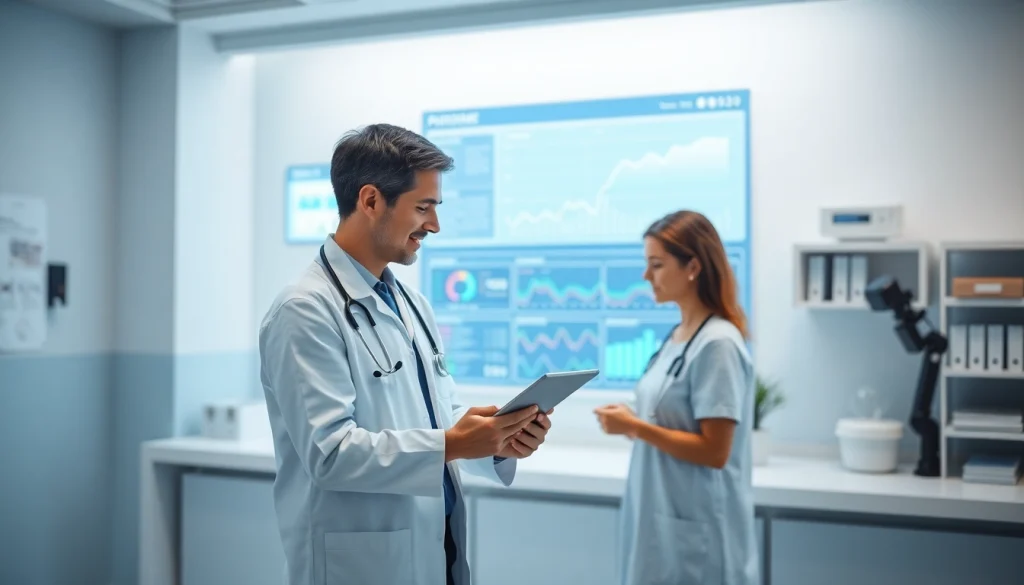Understanding the Fundamentals of Informatics
What is Informatics?
Informatics broadly represents the science of the structure, behavior, and interactions of natural and engineered computational systems. In simpler terms, it is about transforming data into information, and ultimately into knowledge, through systematic methods and approaches. This domain encompasses a range of practices and tools, heavily integrating data science and information technology into various fields, including healthcare, education, and business.
In healthcare, informatics plays a crucial role in improving patient care and streamlining the complexities of medical data management. One of the key platforms that delve deeply into this subject is www.informaticsview.com. This resource encompasses comprehensive insights into how informatics can alter the landscape of health services by applying novel technologies and methodologies.
Core Concepts in Health Informatics
Health informatics integrates principles from computer science, information science, and healthcare to manage and utilize patient information. Key concepts include:
- Health Information Systems (HIS): This refers to a systematic framework designed to collect, store, manage, and transmit health data. HIS enables healthcare organizations to enhance their data management capabilities.
- Electronic Health Records (EHR): These are digital versions of patients’ paper charts, providing a comprehensive view of patients’ medical history over time, helping healthcare providers to make informed decisions.
- Data Interoperability: A crucial aspect that allows different health information systems to communicate effectively, ensuring seamless exchange and utilization of health data across platforms.
- Teleinformatics: The use of telecommunications technology to support health informatics, particularly addressing issues related to remote care and monitoring.
Importance of Data Management in Healthcare
Effective data management in healthcare is vital for achieving enhanced patient outcomes. With measures such as improved accessibility to patient records and efficient data analysis, healthcare providers can significantly reduce errors, streamline processes, and support better clinical decision-making. Furthermore, secure handling of sensitive patient data ensures compliance with regulations such as HIPAA (Health Insurance Portability and Accountability Act) while protecting patient privacy.
Good data management fosters the culture of evidence-based practice. Healthcare professionals can make informed decisions supported by robust data analytics, which can lead to improved patient care pathways and treatment plans. Hospitals and clinics that invest in solid data management systems experience increases in both patient satisfaction and operational efficiency.
Implementing Informatics in Healthcare
Key Tools and Technologies
The landscape of health informatics is not only shaped by the systems but also by an array of tools and technologies that facilitate its implementation. Core components include:
- Electronic Health Record (EHR) Systems: Integral for modern healthcare settings, these systems enhance the storage, retrieval, and management of patient information.
- Clinical Decision Support Systems (CDSS): These provide healthcare professionals with intelligent tools that offer assistance in clinical decision-making, ensuring appropriate care based on the evidence.
- Health Information Exchanges (HIE): Platforms that enable the movement of health information across organizations, promoting data sharing and continuity of care.
- Telehealth Platforms: These frameworks support remote consultation and management of patient health, especially important during times when in-person visits are limited.
Developing Effective Workflows
Establishing efficient workflows is crucial in integrating informatics into healthcare settings. The first step involves mapping current processes to identify bottlenecks or redundancies. By utilizing methodologies such as Lean or Six Sigma, healthcare organizations can redesign workflows that enhance patient care delivery.
A specific focus on user training is paramount—ensuring that all staff members are proficient with the new systems fosters a smoother transition. Regular feedback from end-users can facilitate continual improvements, making workflows more responsive to both patient and provider needs.
Challenges in Adoption and Use
Introducing informatics solutions in healthcare is not without its challenges. Among the most prevalent are:
- Resistance to Change: Healthcare professionals may be hesitant to adopt new technologies due to familiarity with existing processes. Effective change management strategies and inclusive training programs can mitigate this barrier.
- Data Privacy and Security Concerns: Protecting patient information while complying with regulations is both a legal and ethical responsibility. Employing secure technologies and defining clear protocols can alleviate these concerns.
- Integration Challenges: Ensuring that new systems accurately integrate with existing ones is essential for data fluidity. Careful planning and robust integration solutions are key to overcoming such challenges.
Applications of Health Informatics
Improving Patient Care with EHRs
Electronic Health Records have transformed healthcare delivery by making patient information accessible and organized. EHRs not only provide real-time data but also enhance communication between healthcare providers, which leads to more coherent patient management strategies. For instance, an EHR system can remind physicians to follow up on preventive care measures, ensuring that patients receive timely treatments.
Utilizing Clinical Decision Support Systems
Clinical Decision Support Systems (CDSS) leverage patient data and evidence-based guidelines to support healthcare professionals in making accurate diagnoses and treatment decisions. For instance, by analyzing a patient’s history alongside current medical guidelines, a CDSS can suggest potential diagnoses or alert providers to drug interactions. This application not only improves clinical outcomes but also fosters a culture of evidential reasoning in healthcare practices.
Telemedicine and Remote Patient Management
Telemedicine has emerged as a vital aspect of health informatics, particularly valuable in rural areas or during health emergencies when traditional in-person visits might not be feasible. Remote patient management through telecommunication technologies enables continuous monitoring of patients’ health conditions, allowing healthcare providers to intervene proactively. For example, telehealth platforms can facilitate regular check-ins for chronic disease management, leading to better patient adherence and outcomes.
Future Trends in Informatics
AI and Machine Learning in Healthcare
Artificial Intelligence (AI) and machine learning (ML) are at the forefront of health informatics innovation. Their ability to analyze vast datasets enables personalized medicine approaches, predictive analytics for disease outbreak forecasting, and automating administrative tasks, allowing healthcare professionals to focus more on patient care. For instance, AI can analyze patient history to predict the likelihood of hospital readmission, providing patient-specific interventions to mitigate risks.
Data Analytics for Enhanced Decision Making
The rise of data analytics tools in health informatics empowers healthcare organizations to make informed strategic decisions. Advanced analytical methods can assess patient outcomes, operational efficiencies, and financial performance, offering insights that drive improvement initiatives. With real-time data analytics, institutions can respond swiftly to trends or issues as they arise in clinical and administrative settings.
Personalized Medicine and Informatics
Personalized medicine—a tailored approach to treatment that considers individual variability—is increasingly intertwined with health informatics. Informatics tools help clinicians leverage genomic data alongside traditional health data to dictate treatment plans that align precisely with a patient’s unique profile. By employing data-driven insights, healthcare professionals can offer precision therapies that enhance treatment effectiveness and patient satisfaction.
Evaluating Informatics Impact on Healthcare Outcomes
Metrics for Success in Implementing Informatics
Measuring the success of informatics implementations is essential for ongoing improvement efforts. Key performance indicators (KPIs) can be derived to evaluate various dimensions such as:
- Patient Outcomes: Metrics like readmission rates, length of stay, and patient satisfaction can provide insights into how informatics initiatives impact care quality.
- Operational Efficiency: Assessments on workflow efficiencies, error rates in data entry, and time savings attributable to new systems can guide organizational improvements.
- Financial Performance: Evaluating the return on investment (ROI) from informatics projects, including cost savings from reduced errors or streamlined processes, helps stakeholders validate the impact of initiatives.
Case Studies of Effective Solutions
Examining well-documented case studies can illustrate the successful application of informatics in healthcare settings. For instance, a large hospital system may have implemented an EHR system effectively, resulting in a 20% improvement in patient care coordination through better communication channels among staff. Such documented successes provide valuable learning opportunities for other organizations seeking to integrate informatics solutions.
Continual Improvement and Future Directions
As health informatics evolves, organizations must embrace a culture of continual improvement. This requires not only regular training and upskilling of personnel but also adapting systems to meet emerging trends, such as integrating new technologies or addressing unforeseen challenges. Monitoring future directions in technology, patient needs, and regulatory environments will be crucial in maintaining the effectiveness of informatics solutions, ultimately enhancing health outcomes.



